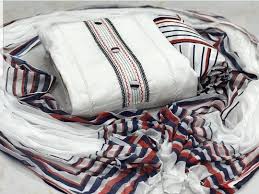Selecting the right dress material can make a big difference in comfort and style, especially when the seasons change. With so many options available, from breathable cotton to luxurious velvet, it can be overwhelming to know which fabric is best suited for each season. Here’s a guide to help you choose the ideal dress material wholesale that keeps you looking stylish and feeling comfortable, no matter the season
1. Summer: Lightweight and Breathable Fabrics
In the scorching summer months, keeping cool is key. Opt for fabrics that allow air circulation, wick moisture, and are gentle on the skin. Here are some top choices:
- Cotton: Known for its breathability and softness, cotton is the go-to fabric for summer. It absorbs moisture and allows air to pass through, making it ideal for hot weather. Cotton dress materials come in a variety of prints and colors, perfect for casual outings and office wear.
- Linen: Linen is another natural fabric that’s perfect for summer. It’s highly absorbent and dries quickly, keeping you cool even on the hottest days. While linen does wrinkle easily, its relaxed look is part of its charm, giving you an effortlessly chic vibe.
- Chiffon: Chiffon is a lightweight, airy fabric that’s great for evening outings or parties. It has a flowy feel, making it ideal for dresses and blouses that need a little movement and flair. Chiffon is often used in floral prints, perfect for the season.
Styling Tip: Pair cotton kurtis or linen tunics with light accessories for a fresh summer look. Add a wide-brimmed hat and sunglasses to complete the vibe.
2. Monsoon: Quick-Drying and Easy-to-Maintain Fabrics
Monsoon season calls for fabrics that dry quickly and are easy to care for, as you may get caught in unexpected rain showers. Here are some ideal options:
- Rayon: Rayon is lightweight, soft, and dries quickly, making it a practical choice for monsoons. It’s less prone to wrinkling and can withstand a little dampness without losing its shape. Rayon is also available in a wide range of colors and designs.
- Polyester: Known for its durability and moisture resistance, polyester is a great fabric choice for the rainy season. It repels water to some extent and dries much faster than natural fibers. Polyester dress materials are available in vibrant prints, ideal for rainy days.
- Blends: Fabrics like cotton-polyester blends combine the best qualities of both materials. They offer the softness of cotton with the quick-drying properties of polyester, making them versatile for unpredictable weather.
Styling Tip: Choose knee-length dresses or kurtis during monsoon to avoid splashes. Pair with waterproof accessories like plastic or rubber shoes for a practical yet stylish look.
3. Winter: Warm and Cozy Fabrics
Winter requires fabrics that provide warmth and comfort while also allowing you to express your style. Choose thicker materials that offer insulation without being too bulky.
- Wool: Wool is a natural insulator and ideal for keeping warm during chilly weather. Wool dress materials are often blended with other fibers to create softer, more comfortable fabrics. You can find woolen dresses, shawls, and scarves to add layers and style.
- Velvet: Velvet is a luxurious fabric with a soft, plush feel, perfect for evening wear and special occasions in winter. It adds a touch of elegance and glamour, making it ideal for party pakistani dress material wholesale and formal gatherings.
- Corduroy: Corduroy has a distinctive ribbed texture and is thicker than most fabrics, providing warmth in the winter months. It’s great for jackets, skirts, and trousers, adding a cozy yet chic touch to your winter wardrobe.
Styling Tip: Layer wool kurtis or velvet blouses with jackets and scarves for added warmth. Pair with boots and accessorize with metallic jewelry to elevate your winter look.
4. Spring: Soft and Floral Fabrics
Spring is all about renewal, flowers, and light breezes. Choose fabrics that capture the season’s freshness and bring out its vibrant colors.
- Silk: Lightweight silk is great for spring, adding a bit of luxury to your outfit while keeping you comfortable. Its natural sheen makes it perfect for both casual and formal wear, and it pairs beautifully with floral patterns.
- Georgette: Georgette is lightweight, flowy, and has a slightly crinkled texture. It drapes well, creating an elegant silhouette, and is perfect for blouses, dresses, and skirts. Georgette is also available in floral prints, capturing the essence of spring.
- Organza: Known for its sheer and delicate appearance, organza is a great choice for spring events and parties. It adds volume without heaviness and can be layered over other fabrics for a sophisticated look.
Styling Tip: Pair floral silk or georgette dresses with dainty jewelry and sandals. Add a light scarf for those breezy spring evenings.
5. Autumn: Earthy and Textured Fabrics
Autumn brings cool temperatures and earthy tones. This season calls for textured fabrics that have a warm and rich feel.
- Khadi: Khadi is a hand-spun fabric known for its texture and earthy appeal. It’s breathable, warm, and has a natural look that suits the autumn aesthetic perfectly. Khadi kurtis or sarees in earthy tones like olive, maroon, and beige make for great autumn wear.
- Tussar Silk: Tussar silk is a natural silk with a slightly rough texture, making it a unique choice for autumn. It’s known for its earthy colors and subtle sheen, perfect for festive occasions in the cooler months.
- Jacquard: Jacquard is a woven fabric with intricate patterns that give it a rich, luxurious feel. Jacquard dress materials are ideal for evening wear and parties, adding a touch of elegance and opulence.
Styling Tip: Choose khadi or tussar silk kurtis in autumnal colors and pair with ethnic jewelry. Layer with a shawl for added warmth and style.
Tips for Choosing the Right Dress Material
- Consider the Occasion: Think about where you plan to wear the dress. Lighter fabrics work well for casual events, while heavier, more luxurious materials are better for formal or festive occasions.
- Check the Weather: Seasons play a significant role in fabric choice. Opt for breathable materials in summer, quick-drying fabrics in monsoon, and cozy fabrics in winter.
- Comfort is Key: While style is important, comfort should always come first. Choose fabrics that feel good on your skin and allow for ease of movement.
- Focus on Maintenance: Some fabrics require special care, like dry cleaning or handwashing. If you prefer easy maintenance, look for low-maintenance fabrics like cotton blends or polyester.
FAQs on Choosing Dress Material for Every Season
1. What is the Best Fabric for Summer?
Cotton and linen are the best choices for summer as they are breathable, lightweight, and comfortable.
2. Which Fabric is Best for Winter Wear?
Wool, velvet, and corduroy are ideal for winter, providing warmth and a cozy feel.
3. Is Rayon Suitable for the Monsoon Season?
Yes, rayon is lightweight and dries quickly, making it a good choice for rainy weather.
4. Can I Wear Silk in Spring?
Yes, lightweight silk is perfect for spring, as it’s comfortable and adds a touch of luxury to your outfit.
5. How do I Choose Fabric for Festive Occasions?
For festive occasions, opt for luxurious fabrics like silk, jacquard, or velvet. These fabrics add a rich look and make you stand out.
Choosing the right dress material is the foundation of a stylish and comfortable wardrobe. By selecting fabrics that suit each season, you’ll not only look fabulous but also feel at ease, no matter the weather or occasion. Happy styling!
AADYA ALLEY Double Layer 2-in-1 Liquid Soap Dispenser with Sponge for Kitchen Dishwashing Liquid Pump 500ml Soap Dispenser with Sponge Holder for Kitchen Sink, Hotels, and Restaurants
₹99.00 (as of 21 November, 2024 18:32 GMT +05:30 - More infoProduct prices and availability are accurate as of the date/time indicated and are subject to change. Any price and availability information displayed on [relevant Amazon Site(s), as applicable] at the time of purchase will apply to the purchase of this product.)SHAYONAM Cordless Portable Wireless Pressure Washer Gun 48V 12000mah High Pressure Water Gun for Car Wash Bike Washing Cleaning| Adjustable Nozzle and 5M Hose Pipe (Double_Battery) (Black)
₹1,699.00 (as of 21 November, 2024 18:32 GMT +05:30 - More infoProduct prices and availability are accurate as of the date/time indicated and are subject to change. Any price and availability information displayed on [relevant Amazon Site(s), as applicable] at the time of purchase will apply to the purchase of this product.)Amazon Basics Electric Egg Boiler | 3 Boiling Modes | Automatic Operation | Overheat Protection|75ml|Plastic|White
₹369.00 (as of 20 November, 2024 18:31 GMT +05:30 - More infoProduct prices and availability are accurate as of the date/time indicated and are subject to change. Any price and availability information displayed on [relevant Amazon Site(s), as applicable] at the time of purchase will apply to the purchase of this product.)Tekcool Manual Hand Press Push Chopper with 6 Blades for Effortless Chopping Vegetables & Fruits (Assorted, 650 ml, Plastic).
₹279.00 (as of 21 November, 2024 18:32 GMT +05:30 - More infoProduct prices and availability are accurate as of the date/time indicated and are subject to change. Any price and availability information displayed on [relevant Amazon Site(s), as applicable] at the time of purchase will apply to the purchase of this product.)2 Pcs Kitchen Mats, Waterproof Memory Foam Kitchen Rugs, Standing Desk Mat Floor Mats, Comfort Runner Rug Carpets for Kitchen Floor, Sink (c)
₹549.00 (as of 21 November, 2024 18:32 GMT +05:30 - More infoProduct prices and availability are accurate as of the date/time indicated and are subject to change. Any price and availability information displayed on [relevant Amazon Site(s), as applicable] at the time of purchase will apply to the purchase of this product.)Discover more from The General Post
Subscribe to get the latest posts sent to your email.





